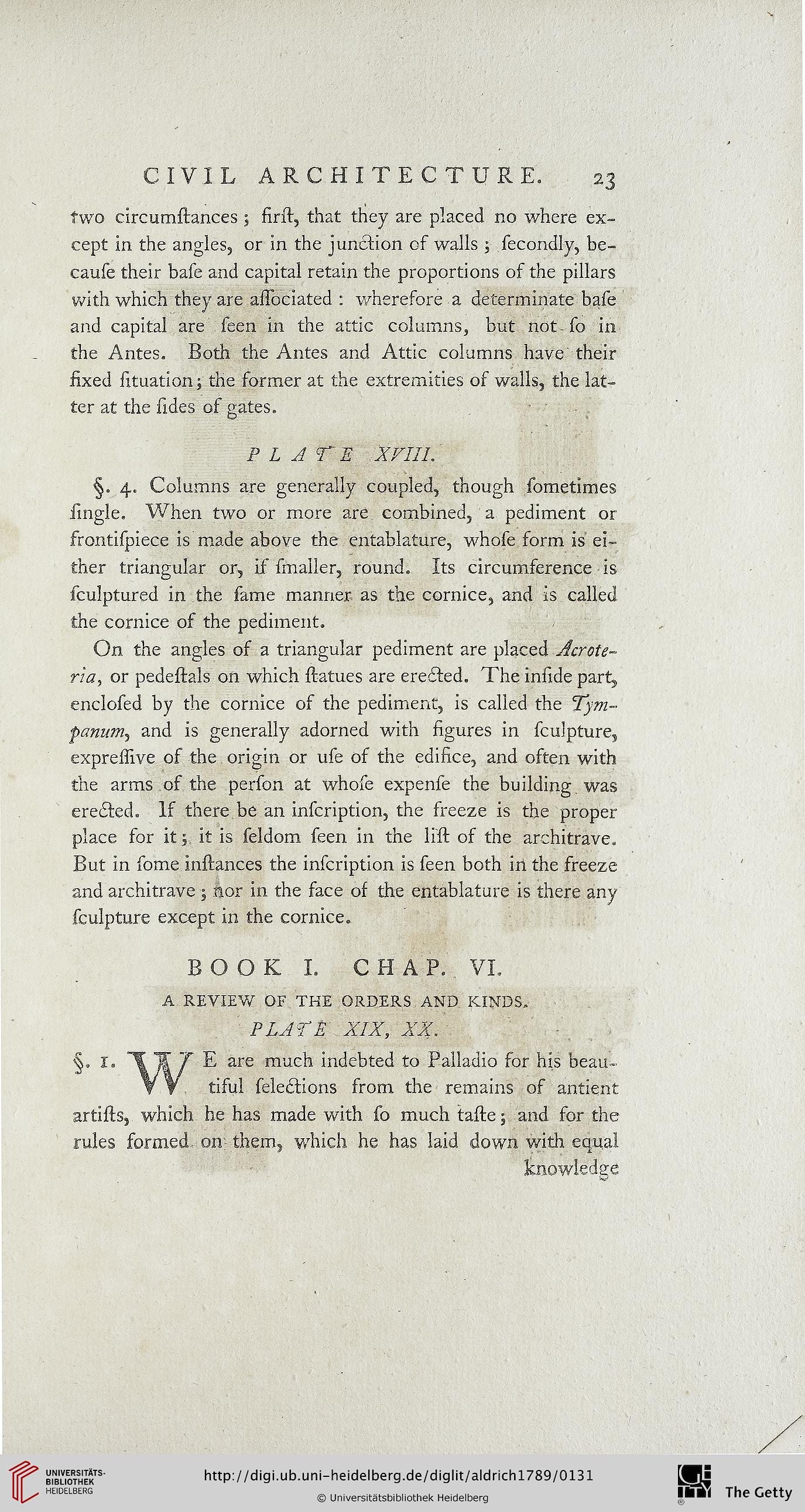CIVIL ARCHITECTURE.
23
two circumstances ; first, that they are placed no where ex-
cept in the angles, or in the junction of walls ; secondly, be-
cause their base and capital retain the proportions of the pillars
with which they are associated : wherefore a determinate base
and capital are seen in the attic columns, but not so in
the Antes. Both the Antes and Attic columns have their
fixed situation; the sormer at the extremities os walls, the lat-
ter at the sides of gates.
PLATE XVIII.
§. 4. Columns are generally coupled, though sometimes
iingle. When two or more are combined, a pediment or
frontispiece is made above the entablature, whose form is ei-
ther triangular or, if smaller, round. Its circumference is
sculptured in the same manner as the cornice, and is called
the cornice of the pediment.
On the angles of a triangular pediment are placed Acrote~
ria, or pedestals on which statues are eredted. The inside part,
enclosed by the cornice of the pediment, is called the Tym-
panum, and is generally adorned with figures in sculpture,
expressive of the origin or use of the edifice, and often with
the arms of the person at whose expense the building was
eredted. If there be an inscription, the freeze is the proper
place for it; it is seldom seen in the list of the architrave.
But in some instances the inscription is seen both in the freeze
and architrave ; nor in the face of the entablature is there any
sculpture except in the cornice.
BOOK!. CHAP. VI.
A REVIEW OF THE ORDERS AND KINDS.
PLATE XIX, XX.
§. I. ^ 7 E are much indebted to Palladio for his beam
V s tiful seledtions from the remains of antient
artists, which he has made with so much taste; and for the
rules formed on them, which he has laid down with equal
knowledge
23
two circumstances ; first, that they are placed no where ex-
cept in the angles, or in the junction of walls ; secondly, be-
cause their base and capital retain the proportions of the pillars
with which they are associated : wherefore a determinate base
and capital are seen in the attic columns, but not so in
the Antes. Both the Antes and Attic columns have their
fixed situation; the sormer at the extremities os walls, the lat-
ter at the sides of gates.
PLATE XVIII.
§. 4. Columns are generally coupled, though sometimes
iingle. When two or more are combined, a pediment or
frontispiece is made above the entablature, whose form is ei-
ther triangular or, if smaller, round. Its circumference is
sculptured in the same manner as the cornice, and is called
the cornice of the pediment.
On the angles of a triangular pediment are placed Acrote~
ria, or pedestals on which statues are eredted. The inside part,
enclosed by the cornice of the pediment, is called the Tym-
panum, and is generally adorned with figures in sculpture,
expressive of the origin or use of the edifice, and often with
the arms of the person at whose expense the building was
eredted. If there be an inscription, the freeze is the proper
place for it; it is seldom seen in the list of the architrave.
But in some instances the inscription is seen both in the freeze
and architrave ; nor in the face of the entablature is there any
sculpture except in the cornice.
BOOK!. CHAP. VI.
A REVIEW OF THE ORDERS AND KINDS.
PLATE XIX, XX.
§. I. ^ 7 E are much indebted to Palladio for his beam
V s tiful seledtions from the remains of antient
artists, which he has made with so much taste; and for the
rules formed on them, which he has laid down with equal
knowledge





